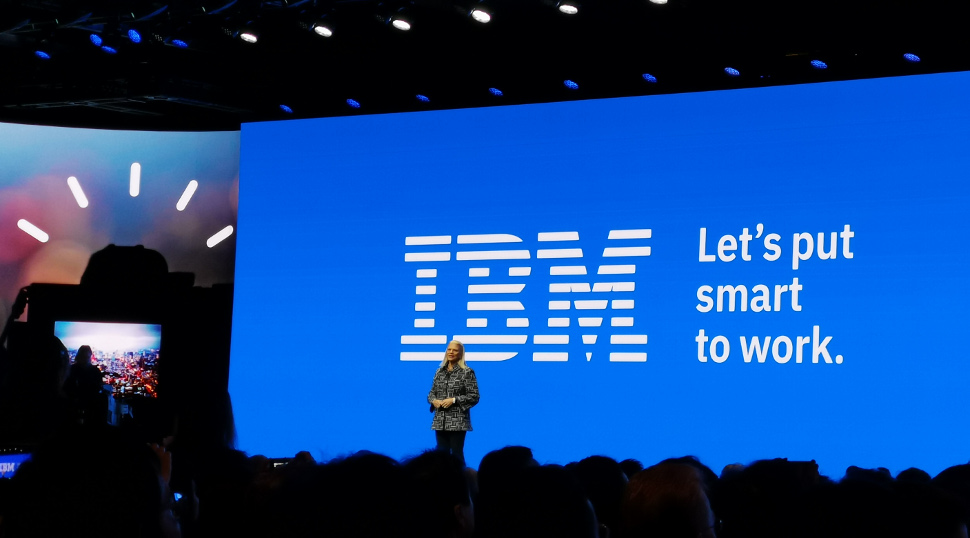Why IBM wants to be the brains behind the world's data
Data is "the next great natural resource", IBM says.

With mountains of data being created every day, the need for sophisticated compute systems to process and get the most out of it are becoming more important than ever.
IBM CEO Ginni Rometty gave the opening keynote at CES 2019, highlighting the potential of “deep data” - the vast amounts of information created every data by smart systems around the world which isn’t currently being collected or analysed.
In her keynote, Rometty announced a new partnership with the Weather Channel which will see IBM’s computing expertise help create “hyper-local” forecasts. These reports will utilise the huge amounts of untapped data to build accurate forecasts which could affect a wide range of aspects of everyday life, from farming to transport.
Following the keynote, TechRadar Pro spoke to Bridget Karlin, Chief Technology Officer and VP of IBM's global technology services business, who was keen to highlight the potential of “deep data”, noting that people generate 2.5 quintillion bytes of data (or 2.5 billion gigabytes) per day - but this is “a fraction of one percent” of all the data being created worldwide by connected smart devices.
This amount will only continue to grow, but even this is not enough data for some of the ambitious models IBM wants to pursue, she says.
Broadening AI
This includes another new area of focus for IBM, what the company is calling “broad AI”. As it stands, IBM says that AI deployment is fairly narrow, and still to reach its full potential and graduate to truly human AI.
Broad AI is the step between the two stances, helping bridge the gap between technology and humanity, making AI more useful and accessible by creating more naturalistic engagements.
Are you a pro? Subscribe to our newsletter
Sign up to the TechRadar Pro newsletter to get all the top news, opinion, features and guidance your business needs to succeed!
As Karlin says, “we're really taking on a very broad challenge and seizing the opportunity of bringing technology forward that can help us scale knowledge, accelerate learning, and enrich decision-making.”
“If you think about the power of data, and the power of AI coming together, and the journey we’re on, from narrow to broad to general...it really brings up so many possibilities.”
“IBM is working on a broad range of advanced technologies, always with an eye on how IBM can impacting how the world works, and hope we can leverage technology for good.”
Expanding quantum
In her keynote, Rometty described data as “the next great natural resource” in her keynote, and the potential this has for the industry as a whole. Karlin described how the technology space is currently witnessing a convergence of many different technologies, such as 5G, AI and IoT, all of which create mountains of data and depend on a huge amount of computing power in a major paradigm shifts that is enabling a new world of experiences
A key part of this will be the development of quantum computing, an area that IBM made a significant announcement on during CES 2019.
The company revealed IBM Q System One platform at the show, its first integrated universal quantum computing platform. Described as the first “commercially available” quantum computing system, the new service means that the technology is finally able to break free from the laboratory to help a wider range of organisations than ever before.
“This is a completely different step change for humanity in what we can do,” Karlin notes, adding that the new models enabled by the platform can extend the possibilities of what compute can do.
So as the technology industry takes its next steps into a data-driven world powered by quantum computing, IBM is firmly positioning itself as the enabler of these next-generation experiences.
“Every single company is, or is becoming a tech company,” Karlin says, “we understand that - it's messy, and it’s transformative, but we want to lead our clients through that.”
“We're in an extraordinary time for technology...and as we move to the era of broader intelligence and AI, it’s more exciting and there’s a world of possibilities in front of us.

Mike Moore is Deputy Editor at TechRadar Pro. He has worked as a B2B and B2C tech journalist for nearly a decade, including at one of the UK's leading national newspapers and fellow Future title ITProPortal, and when he's not keeping track of all the latest enterprise and workplace trends, can most likely be found watching, following or taking part in some kind of sport.